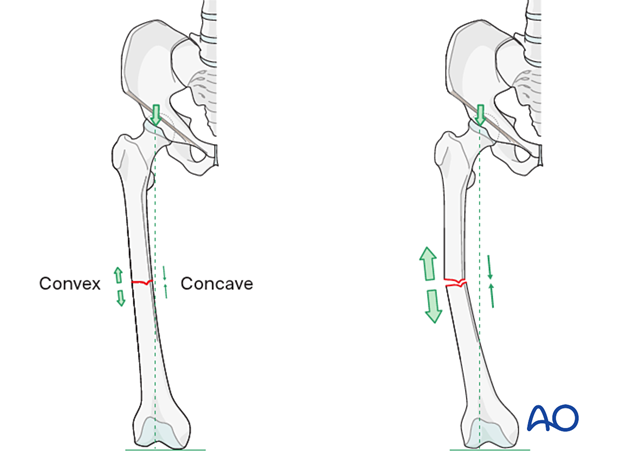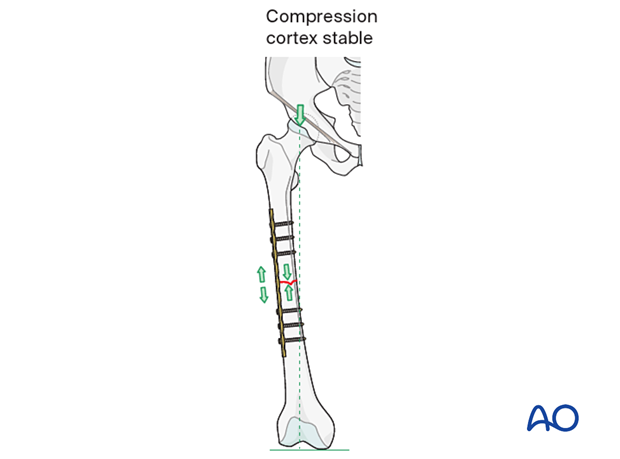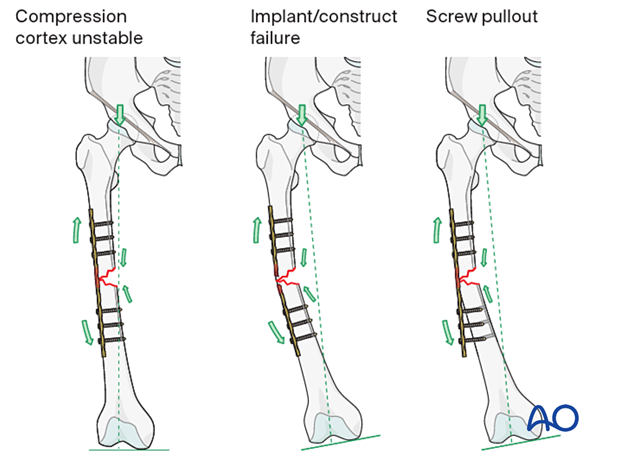Tension band principles
1. Introduction
The tension band mechanism is a frequent feature of human anatomy, especially in the long bones and their adjacent joints. The same mechanism can be applied to treat fractures in bones that are eccentrically loaded.
The eccentric load may be due to either body weight, muscle pull, or both.
2. Definition
A tension band is any device placed on the tension side of an eccentrically loaded fracture that converts tensile load into compressive load.
The convex side of the bone is under tension whereas the concave side is under compression.

This illustration shows how tension bands convert tensile load into compressive load.

3. Correct use
For a tension band to work, the fracture site must be eccentrically loaded. In addition, the construct must withstand compressive forces on the compression side, ie the compression cortex must be stable.
NB Internal fixators, such as locking plates with locked screws, share the load mainly through the implant, and the effect of the tension band is relatively less important.

If there is insufficient support on the compression side due to comminution or a fracture gap an implant used as a tension band may fail due to implant fatigue.
Additionally, if the bone quality is poor, the fixation may fail by pullout of the implant from the bone.

These 3D models show a plate applied to the tension side of a bone. In the lower model there is insufficient support on the compression side due to comminution. This leads to the implant seeing significantly higher strain, and may ultimately lead to implant failure under axial load.
4. Clinical applications
The tension band principle is commonly applied to:
- Scapular spine
- Acromion
- Dorsal side of the ulna
- Greater trochanter
- Lateral side of the femur
- Fibular head
In the past, the term “tension band” has also been applied to constructs used to fix fractures of the following:
- Greater tuberosity
- Olecranon
- Patella
- Medial malleolus

In some periarticular and articular fractures, eccentric loading on the tension side may vary. This may result in nonuniform compression or possible distraction on the tension side. For this reason, it may not be accurate to use the term “Tension band” in these contexts.
However, in good quality bone with a simple fracture configuration, compression osteosynthesis by K-wire transfixation and cerclage is still an option. This is called “Cerclage compression wiring”.

Teaching video
5. References
Brink PRG, Windolf M, de Boer P, et al. Tension band wiring of the olecranon: is it really a dynamic principle of osteosynthesis? Injury. 2013 Apr;44(4):518-22.
Stoffel K, Zderic I, Pastor T, et al. Anterior variable-angle locked plating versus tension band wiring of simple and complex patella fractures – a biomechanical investigation. BMC Musculoskelet Disord. 2023 Apr 11;24(1):279.
Thelen S, Schneppendahl J, Jopen E, et al. Biomechanical cadaver testing of a fixed-angle plate in comparison to tension wiring and screw fixation in transverse patella fractures. Injury. 2012 Aug;43(8):1290-5.













